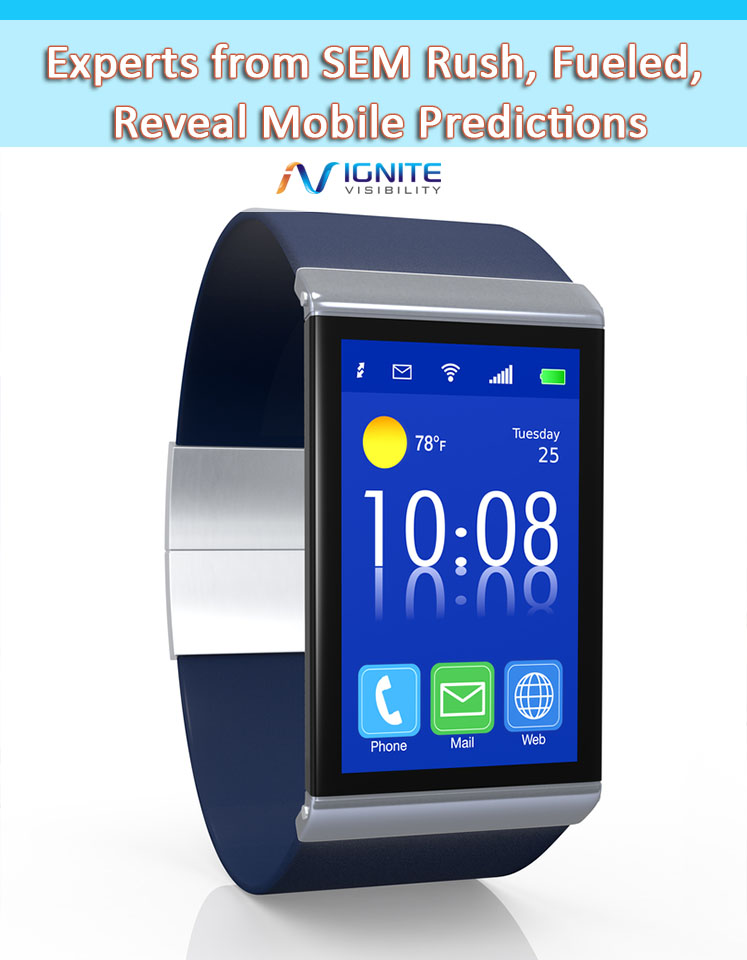People are moving to mobile in a big way. Most people have smart phones and it is becoming easier and easier to accomplish everything you need to do on a smartphone. Nowadays, a smart phone can do almost everything a desktop can, including online shopping and making purchases. Listen to what these experts think will be some of the most important changes we will see mobile make on online marketing and ecommerce in 2015.
———————————–
This is something we spend a lot of time thinking about here at Fueled. Devices like the new bigger iPhones are making it even easier to move away from laptops as one’s primary computing device.
We expect trends towards mobile-primary and mobile-only users to continue, it not accelerate in 2015, as bigger devices and seamless payment tools like Pay continue a march towards making mobile commerce an easier and better experience than traditional ecommerce.
Why go to a computer where checking out means typing in a long credit number on an insecure website when using your phone means you can pay with your fingerprint?

Ryan Matzner
Ryan Matzner
Director and Chief Strategist at Fueled
———————————–
Mobile devices have becomes first point of access for information. Mobile is not just limiting itself to access information and make communication but also to take action. People are beginning to trust mobile devices for travel, purchases, movies, coffee, etc.
Consumers now spend more time interacting with online retailers on smartphones and tablets than they do on desktops and laptops. According to a study by comStore, Smartphones accounted for 44% of retail Internet minutes while tablets accounted for 11%. The numbers in other countries are a sign of things to come here in the United States. A recent story in The Guardian reported that Online shopping on mobiles in the UK has overtaken desktops for first time.
These consumer patterns reflect the importance of engaging customers by mobile. Consumers want things done in minutes A simplistic and personalized design for accessing information, capturing leads, showing ads, having dialogues with consumers has become paramount.
Brands can attain a better ROI by investing in tracking behaviors on mobile phones. Engagement behavior can be used to generate data that technology platforms can leverage to deliver highly targeted messages. Brands can provide relevant and targeted messages and aim for customers based on needs, desires, preferences, demographics, etc.
Personalized, meaningful interaction and mobile campaign success can be a reality. Advertisers and brands simply need to use smart creative combined with technology to make their messages personal. Mobile “is” personal, it’s time advertising is too.
Shekhar Deo
Co-founder of EngageClick
———————————–
Convergence. comScore reported in August that the tipping point has already been reached… mobile devices (smartphones and tablets) account for 60% of time spent on digital media. Apps now consume 52% of our digital media time. It follows that Apps command 83% – 90% of our mobile attention (comScore, Nielsen). Mobile Ad platform NinthDecimal reports smartphone use for shopping purposes increased, as 45% of consumers made a purchase after seeing a mobile ad. Google Wallet, Amazon Payment and Apple Pay wait in the wings to satisfy the urge for security and convenience. iBeacon shifts the scale of geo-location down to the aisle level, for in-store targeted offers and customer recognition.
“Would you like a pair of 20%-Off suede boots to go with those jeans you purchased last week?” said the smartphone.
Two issues emerge: 1) ‘App ghettoes’, where a few apps get most of the use, and 2) multi-screening behavior challenges advertiser’s ability to effectively target prospects who move from TV to smartphone to voice search to app.
Michael Stricker
U.S. Marketing Director for SEMrush
———————————–
Form factor – It will be vital for brands to take in to account different form factors as they roll out their mobile campaigns. Mobile campaigns can quickly be compromised if brands don’t think about the impact on display and the call to action across various screen sizes.
The mobile marketing tipping point – Mobile marketing will evolve to be more than just a tactic and be embraced as a core part of the marketing strategy. With the goals being relatively the same as traditional marketing, marketers will be able to attract, engage and retain new and existing customers through highly relevant content based on location, interests and interactions throughout the mobile lifecycle.
Discovery to purchase on the mobile device – There will be a more conscious effort to remove the silo’s across organizations to collaborate across screens, channels, and messages to deliver ONE consistent experience to consumers wherever they are in their purchasing lifecycle.
Connecting the dots across all mobile channels – Marketers need better tools to understand how their campaigns are performing across the entire mobile lifecycle, including mobile ads and messaging, QR Codes, mobile website, branded apps and social media. With these insights, marketers will be able to optimize their campaigns to better understand the triggers that lead consumers down the path-to-purchase.

Greg Hoy
Greg Hoy
Vice President of Mobile Solutions at Hipcricket
———————————–
Mobile websites will move closer to feeling and acting like native apps.Responsive design will continue to be important, to provide the best experience all the various screen sizes available among the various phones and tablets. We’ll also need to start considering other ways to access the mobile web — wearable devices, connected vehicles and more. Accessing the web from a watch or a pair of glasses is not out of the question when you consider where Google, Samsung and Apple are going.
Ultimately, it’s important to present your website’s content in easy to use, bite-size chunks that will be easy to read on any device.
We are seeing that, for a large segment of consumers, smartphones and tablets are their go-to ways to access the Web, with desktops as a fall-back. With advances in mobile design and mobile payment technology, it’s becoming much easier to remove friction from the purchasing process, which should greatly benefit ecommerce sites.
That said, there are still lots of instances when it makes sense to use a desktop, like when you’re filling out a long form application for an apartment lease or a mortgage.
If your website isn’t mobile by now, you’re already behind the times. You’re basically telling 30-50% of your customers (or more), “we’re not interested in providing you a great online experience.”
I think responsive design wins out over mobile-optimized sites because mobile now means so many different screen sizes— from smartphones to tablets. It’s also easier for content management purposes and helps with search engine optimization, because it prevents the need to create multiple pages of content for different devices.
Smart marketers will personalize the website experience by leveraging the hardware capabilities of consumers’ mobile devices (such as location, phone/SMS, digital wallet apps, etc.), online behavior and social connections of website visitors.
Using a device’s location capabilities to enhance or modify the shopping experience is one way to do this. If you know a consumer’s location, you can give them information that is relevant to where they are, like the deals available at a store near them.
Using social media to compliment product information on a company’s website is another option. If you know who a consumer is on social networks and who they’re connected to, you can give them information that will help them make a buying decision, such as a review from one of their friends.
Beyond websites, native apps will continue to be more important, as we are seeing many consumers spending more time in apps than on the mobile Web. Mobile apps can further leverage the capabilities of the phone, using tools like notifications, reminders and calendar events to make consumers aware of the latest offers.
We also believe that email will continue to be important on mobile. Research has shown that more people are viewing emails on mobile than on desktop devices, so email will continue to be an effective tool for marketers to drive targeted traffic into their websites and apps.
Marketers will also want to keep an eye on newer features in social advertising. Both Twitter and Facebook are testing “buy now” buttons that give consumers the ability to make a purchase through their social feeds, and Pinterest is continuing to develop their promoted pins with real time pricing.

Mike Whaling
Mike Whaling
President of 30Lines
———————————–
The biggest impact of mobile will be on local commerce. Already, we are seeing that 80% of local searches start on mobile devices and more than 50% of searchers actually walk into the store compared to 34% for desktop searchers. Almost half of these searches are for contact information, location and driving direction. As more businesses use location extensions, we will see local ads driving more and more traffic to stores. We will see more apps focused around completing local transactions. For example, I may be able to search for a nearby store carrying my favorite golf balls, pay for it using integrate mobile payment, and get directions to the store so I can pick up the balls on my way to the golf course. It will level the playing field to a great extent for local small businesses.
Vishal Srivastava
Trainedge
———————————–
With Apple Pay launching soon and other options now available, mobile payment usage will spike as early technology adopters flock to it. Big companies will quickly adopt Apple Pay at their stores to take advantage of the more than ten million consumers who will have access to it through the latest iPhones, and small businesses will follow suit. Complementary businesses are going to develop partnerships that encourage users to get on board with the new technology and also leverage it to cultivate customer loyalty. For example, we may see spas, gyms, and health food stores partner to offer joint loyalty and rewards programs that offer discounts, specials and other incentives via joint mobile-focused initiatives and campaigns.
Li-at Karpel Gurwicz
Como VP Marketing
———————————–
Mobile and social trends continue to converge, driving social commerce on mobile devices, particularly for fashion and lifestyle. With mobile traffic on the rise, technology improvements like Apple Pay, and social adoption of phones as lifestyle hubs to connect and manage our lives, mobile commerce will grow exponentially.
Consumers’ phones are “always on,” tools used to filter and archive experiences and memories, through 100M+ pictures shared daily. Increasingly, these feature favorite and recommended products, shared across social networks.
This creates overwhelming opportunity for social commerce. The fashion industry uses consumer selfies and street style in content marketing, showing products on real people in situ. Curating this content – and allowing consumers to capture content to use in their own style creations – is a growing trend. Brands will continue to produce beautiful, editorial selections, but consumers will demand the ability and access to make brands in their own style, as they live it, wear it, style it and wish to share it.
Technology drives these changes: visual recognition, automated search and tagging capabilities enabling click-to-purchase, tracking abilities to see and reward cross-channel sales influence from consumer brand ambassadors. Shoppers will expect to easily access product information, tag selfies and earn recognition for contributions, transforming CRM and shopping.
Tadd Spering
CEO of Stylinity



